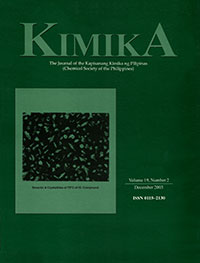An approach to optically active ibuprofen through whole-cell and enzyme-catalyzed transformations
DOI:
https://doi.org/10.26534/kimika.v19i2.69-75Keywords:
ibuprofen, biotransformation, enzyme-catalyzed reduction, lipase-catalyzed resolutionAbstract
Synthesis of optically active ibuprofen is attempted using two methodologies: (1) via yeast-catalyzed reduction of phenyl acrylic acid or ester 1 and derivatives 2 wherein no reduction products were detected in the biotransformation culture medium; and (2) via lipase-catalyzed resolution of racemic phenyl propanol and ibuprofen alcohol. The latter method afforded optically active ibuprofen alcohol as the (-)-S-enantiomer.Downloads
Published
2003-12-01
How to Cite
Endoma, M. A. A., Tria, M. C. R., & Arco, S. D. (2003). An approach to optically active ibuprofen through whole-cell and enzyme-catalyzed transformations. KIMIKA, 19(2), 69–75. https://doi.org/10.26534/kimika.v19i2.69-75
Issue
Section
Research Articles
License
Authors who publish with this journal agree to the following terms:
- Authors retain copyright and grant the journal right of first publication with the work simultaneously licensed under a Creative Commons Attribution License that allows others to share the work with an acknowledgement of the work's authorship and initial publication in this journal.
- Authors are able to enter into separate, additional contractual arrangements for the non-exclusive distribution of the journal's published version of the work (e.g., post it to an institutional repository or publish it in a book), with an acknowledgement of its initial publication in this journal.
- Authors are permitted and encouraged to post their work online (e.g., in institutional repositories or on their website) prior to and during the submission process, as it can lead to productive exchanges, as well as earlier and greater citation of published work (See The Effect of Open Access).





